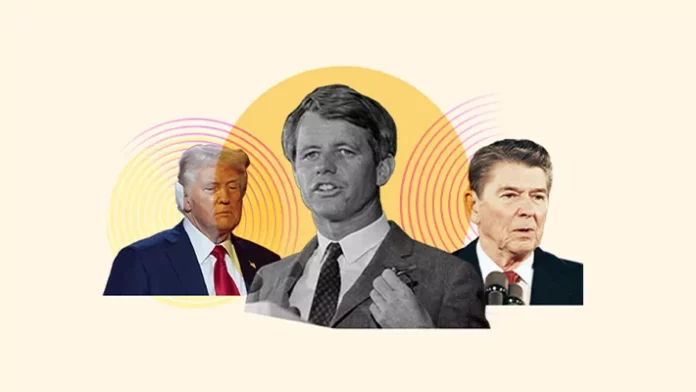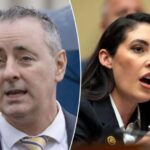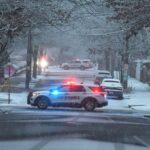
The most memorable piece of information from my Bush-Quayle-era AP Biology class has nothing to do with cellular mitosis, genotypes, or, really, any scientific concept. Rather, it’s our long-tenured John Muir High School teacher, Al Razum, recalling how, more than 20 years earlier, FBI agents came calling on his classroom on a sad June 1968 morning, with students at their desks, right after the assassination of Democratic presidential candidate Robert F. Kennedy.
Federal agents wanted any information they could gather on Sirhan Sirhan, who some years earlier was a student at the Pasadena, California, public high school. Sirhan stood accused of assassinating Kennedy, the former attorney general, senator from New York, and, most famously, younger brother of slain President John F. Kennedy. The crime had taken place at the Ambassador Hotel in Los Angeles, about 15 miles away, in what today is the city’s Koreatown neighborhood. Sirhan was convicted on April 17, 1969, and remains in prison today at age 80.
A similar investigation recently played out in and around Butler, Pennsylvania, north of Pittsburgh. FBI agents interviewed former teachers and former classmates of Thomas Matthew Crooks — and anybody else who had been in contact with him recently. The 20-year-old had notched an unenviable place in presidential history when, around 6 p.m. on July 13, he shot at former President Donald Trump, now the 2024 Republican presidential nominee, from the roof of a building about 400 feet away from a campaign rally stage where the candidate was speaking.

A bullet that struck Trump’s right ear came inches away from killing him. But a crowd member, Pennsylvania firefighter Corey Comperatore, 50, was killed. Two other rally attendees, David Dutch, 57, and James Copenhaver, 74, were injured. A Secret Service sniper killed Crooks seconds after he fired at the former president.
It’s the first comparable incident involving a president or presidential candidate since Ronald Reagan was shot in 1981. In U.S. history, four presidents have been assassinated — a terrible record considering only 45 people have held that office.
Kennedy, at the time of his murder by the Palestinian Jordanian Sirhan over support for Israel, was a leading contender for the 1968 Democratic presidential nomination. Had Kennedy lived, he could have plausibly beaten Republican Richard Nixon, the ultimate victor of that chaotic and tragic year. And unsuccessful attempts on the lives of presidents have reverberated for years after, in unexpected ways.
The sad string of presidential assassinations
The first presidential killing shockingly spurred little change in protecting the commander in chief. To say Abraham Lincoln’s assassination on April 14, 1865, at Ford’s Theatre in Washington, D.C., changed the course of history is a wild understatement. Except in one area, presidential security, where needed obvious, dramatic improvement, was in short supply. Instead, Lincoln’s killing by actor and Confederate sympathizer John Wilkes Booth was viewed as a final, tragic chapter to the Civil War, which took more than 600,000 lives cumulatively.
Little had changed in terms of chief executive protection when President James A. Garfield was fatally shot on July 2, 1881, at the Baltimore and Potomac Railroad Station in Washington — Garfield died on Sept. 19 amid poor medical care even for the time. In the wake of Garfield’s death, after only six months in office, there still was little clamor for presidential protection. Public officials’ need for a connection to regular people was the highest priority, public opinion went at the time. And waves of immigrants were arriving from Europe, with newcomers escaping monarchical regimes where Praetorian Guard-like units were the norm. Such measures drew deep public skepticism.
It was only after the assassination of President William McKinley that the Secret Service added protecting presidents to its duties, which until then focused largely on fighting currency counterfeiting. Even after McKinley was fatally shot on Sept. 6, 1901, at the Pan-American Exposition in Buffalo, New York, protection was limited and, at times, haphazard. It would take several decades to become a full-time part of the president’s entourage.
Intense security measures were in place by the time of President John F. Kennedy’s murder on Nov. 22, 1963, in Dallas, though, obviously, not nearly enough to prevent the Texas tragedy.
The Warren Commission, appointed by President Lyndon Johnson to investigate his White House predecessor’s assassination, noted that no one thought to check the buildings along the Dealey Plaza motorcade route in Dallas. The Secret Service also had no formal procedures for working with local law enforcement agencies.
The agency set about fixing these and other shortcomings in the subsequent years. For instance, presidents no longer sit in open vehicles but wave to onlookers through the thick glass of a heavily armored limousine nicknamed “the beast.”
President-adjacent assassination attempts
It’s been failed efforts to kill presidents and a successful assassination of a would-be president that arguably have brought the biggest changes to Secret Service procedures.
Such as the Nov. 1, 1950, attempt by two Puerto Rican nationalists to assassinate President Harry S. Truman. The assault took place outside of Truman’s temporary home at Blair House, across the street from the White House, while the executive mansion underwent renovations. One of the gunmen was killed, along with a White House policeman. Truman, who remained inside, was unhurt.
Only after the Truman attack, a full half-century after McKinley was the third sitting president killed, did Congress finally enact legislation that permanently authorized Secret Service protection of the president. Until then, Secret Service protection had to be re-upped annually in federal spending bills — which it always was. The 1951 law also authorized Secret Service protections for the president’s immediate family, the president-elect, and the vice president, if he wished. Eleven years later, not long before the Kennedy assassination, Congress expanded coverage to require the vice president, among others, to be protected.
Still, major public figures were vulnerable, as the nation and world tragically learned on April 4, 1968, when civil rights leader Martin Luther King Jr. was killed in Memphis by escaped convict James Earl Ray. Today, a figure such as King would have at least private security, the way Trump, a television star and business mogul, did before declaring for president in June 2015. (That’s not in any way to compare the legacies, accomplishments, moral standing, etc., of the two men.)
Robert Kennedy’s death two months later happened as he soared into a seeming lead for the 1968 Democratic presidential nomination after Johnson bowed out amid unpopularity over the war in Vietnam. Due to that assassination, Congress authorized the protection of major presidential and vice presidential candidates and nominees. A separate law expanded other Secret Service protections, such as for the widow of a former president until her death or remarriage. Minor children of a former president were granted protection until they reached 16 years of age unless protection was declined.
Thirteen years later, the Reagan assassination attempt led to other tangible, if less visible, changes to presidential protection. Particularly because it happened just three months after the New York City murder of former Beatle John Lennon, and two months before the unsuccessful assassination attempt on Pope John Paul II in Vatican City.
In Reagan’s case, the president was coming out of the Washington Hilton hotel when John Hinckley Jr. opened fire from a crowd of onlookers and journalists just 15 feet away. Hinckley got off six shots before Secret Service officers tackled him. The last shot ricocheted off a limo and into Reagan.
After that, presidential events became increasingly White House-centered rather than out-and-about in Washington or anywhere the commander in chief traveled. Presidents also were driven into buildings through underground parking garages. When that wasn’t possible, a cover was erected around the entrance to obstruct the line of sight as the president got into or out of a vehicle.
The White House’s Rose Garden became a frequent site of presidential events. While once reserved for major events of state, such as the 1979 signing of the Egypt-Israel peace treaty during President Jimmy Carter’s administration, the Rose Garden was used for routine events. In 1996, President Bill Clinton signed welfare reform legislation. President George W. Bush presided over a Teacher of the Year awards ceremony in 2002. In a 2020 Rose Garden event, Trump celebrated his third Supreme Court justice, Amy Coney Barrett, being confirmed.
The change to a more bunker-like presidential security approach came in part at the behest of then-first lady Nancy Reagan.
“She became a bigger worrier, especially when it came to her husband’s safety,” the Los Angeles Times reported in March 2016 a few days after her death at age 94. “But it also marked a turning point, in which she took a more assertive role in expressing her views on matters of security, scheduling, and policy, often to the frustration of White House aides.”
However, Nancy Reagan wasn’t the only one pushing for enhanced presidential security arrangements. The Secret Service was already moving in that direction after a pair of unsuccessful assassination attempts against President Gerald Ford in September 1975 during separate visits to Northern California.
Each represented just the sort of public-facing risk the Secret Service wanted to mitigate. The first occurred on the state Capitol grounds in Sacramento, California, where Ford was walking to the building to pay a courtesy call to Gov. Jerry Brown, a Democrat elected the previous November. The second happened in downtown San Francisco after Ford exited a building where he had given a speech and before entering his limousine.
There was always a certain irony about Ford’s brushes with assassination attempts and good fortune eluding them — for him and the nation. Ford had been on the Warren Commission, appointed by Johnson. As a Michigan congressman, Ford was a member of the House Appropriations Committee, which funds federal agencies. The 38th president knew more about the logistics and mechanics of presidential protection than White House predecessors or successors in either party.
Bureaucratic shuffle for the Secret Service
The July 13 Trump assassination attempt was only the latest in a string of negative headlines for the Secret Service. And some unflattering agency problems have lingered for years.
An uninvited couple was able to crash a November 2009 state dinner hosted by President Barack Obama and first lady Michelle Obama, and numerous people were able to slip past security and get close to the president and first family. Then in 2012, Secret Service agents hired prostitutes on a trip to Colombia, where they were supposed to be setting up security for a visit by Obama. In 2015, the House Oversight and Government Reform Committee concluded the Secret Service is an “agency in crisis” after a series of high-profile embarrassments. The congressional report faulted both leadership failings within the agency and budget cuts imposed by Congress that have led to what the committee concluded was a “staffing crisis.”
Many argue the problems go back to the 2003 move of the Secret Service from its longtime Treasury Department home to the newly created Department of Homeland Security. Now, under DHS, more than 20 years into the behemoth department’s existence, the Secret Service is just one of several agencies competing for annual appropriations.
CLICK HERE TO READ MORE FROM THE WASHINGTON EXAMINER
Moreover, Secret Service protection remains a touchy political subject. A son and namesake of the late Robert F. Kennedy, Robert F. Kennedy Jr. is running for president as an independent against Trump and the likely Democratic presidential nominee, Vice President Kamala Harris. Kennedy Jr., 70, for months, said he requested and was denied Secret Service protection. As Robert Kennedy’s son and John Kennedy’s nephew, the pleas had a certain public resonance. President Joe Biden’s White House long declined to provide him with security coverage, but it relented after the Trump assassination attempt and before Biden dropped his reelection bid and yielded to Harris.
The Trump assassination attempt, coming less than four months before the Nov. 5 general election, is likely to spur changes to Secret Service operations and the presidency in ways that aren’t yet clear. Interviews with people who knew the Trump shooter will yield some information, as did post-Robert Kennedy assassination queries to high school teacher Mr. Razum, who died at age 96 in 2016. Though it’s a tragedy, such interviews have been, and likely will be, necessary in a democracy where political violence has occurred much more than we would like to think.









